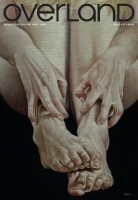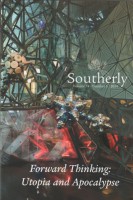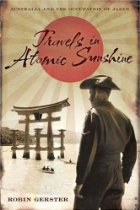Elizabeth McMahon and David Brooks (editors), Southerly Vol 75 No 3 2015: War and Peace (The Journal of the English Association, Sydney, Brandl & Schlesinger 2016)
In last May’s Quarterly Essay, Blood Year, David Kilkullen quoted Trotsky: ‘You may not be interested in war, but war is interested in you.’
The only war to take an active interest in me (so far) was the US war in Vietnam. I attended fiery Front Lawn meetings at uni, marched in Moratorium rallies, was punched in the head by a policeman and beaten up, incompetently, by a neo-Nazi. My birthdate came up in the conscription lottery, I went to court and was granted conscientious objector status. On Anzac Day this year, I commemorated those times by wearing a white feather along with a sprig of rosemary.
So I’m glad to see that this War and Peace themed issue of Southerly includes a voice from the resistance part of the war story, in ‘Wanted for War’, a short memoir of the 1960s by Michael Hamel-Green. (Hamel-Green is one of many men and women interviewed for Hell No! We Won’t Go, a documentary about draft resistance during the Vietnam War currently being made by Brisbane filmmaker Larry Zetlin. The project has a facebook group. Excerpts from Hamel-Green’s interview are here, here and here.)
Eloquent voices from other perspectives are also represented: ‘Eye into Eye’, a short story by Peter Dickison, formerly an officer in ‘various Special Forces units of the Australian Army’ is a convincing evocation of a terrible incident in Afghanistan and its long aftermath; ‘Iran–Iraq War: Diplomats on the Ground’, a memoir by former Ambassador to Iraq Rory Steele, captures the strangely removed world of diplomats in a time of war; Tessa Lunney’s short story ‘V’ consists of five linked monologues from survivors of World War Two – two Russian soldiers, a woman from Berlin, a British officer, and a Jewish survivor of a death camp; Beth Spencer’s poem ‘The Nine Principles of Breema’ imagines its way into one of Australia’s inhumane and illegal offshore detention camps.
There’s cultural history:
- Robin Gerster’s ‘Our Ground Zero: Future Wars and the Imagined Destruction of Australia’s Cities’ extends his work about Australia and the nuclear bombing of Hiroshima and Nagasaki in his wonderful book Travels in Atomic Sunshine and in a previous Southerly, this time writing about Australian novels about nuclear devastation in the decades since 1945.
- Moreno Giovannoni’s ‘When the War Came to San Ginese’ is an excerpt from his forthcoming Tales from San Ginese. It’s at least the second excerpt to appear in Southerly, and I look forward to the book itself.
- ‘Aileen Palmer: Political Activist and “poet of conscience”‘ is part of Sylvia Martin’s project to salvage the reputation of this heroic woman, up until now known mainly as the ‘tragic daughter’ of Vance and Nettie Palmer. Here she emerges as a rare literary person who actually volunteered to be part of the International Brigade in the Spanish Civil War, to work as nurse and translator. Martin’s biography of Palmer, Ink in her Veins, was published earlier this year. If this essay is any indication, it’s well worth reading.
- Two articles revisit the story of Anzac. In ‘Writing the Anzac legend: The Moods of Ginger Mick’ Philip Butterss explores CJ Dennis’s role in creating that legend. Ffion Murphy and Richard Nile’s ‘The Naked Anzac: Exposure and Concealment in AB Facey’s A Fortunate Life’ hold that much-loved book up against the historical documents, and discover that Facey misrepresented his childhood suffering and war experience. Neither of these essays is the kind of academic nit-picking those descriptions might suggest: taken together, they deftly challenge what we are being urged to take as a national foundation myth. In particular, Facey’s apparent evasions of the fact that much of the damage he suffered in the trenches was mental and emotional rather than physical are discussed respectfully as an unsuccessful attempt to deal with that damage.
Not all the poems are on theme. Of those that are, apart from Beth Spencer’s poem that I’ve already mentioned, the most telling are Brook Emery’s ‘The Brown Current’, which counterposes scenes from peaceful Bondi with events from conflict zones, Lorraine McGuigan’s ‘Questions’, a lament for a ten-year-old girl suicide bomber, and Anne M Carson’s ‘Of the 2,700: one voice’, which visits the Nazi murders. Off topic, Jordie Albiston’s ‘Δ4’ is a 10-syllables-to-a line joy.
There’s more, including 21 ages of reviews, and a number of scholarly essays. All in all, this is a fabulous issue.
—–
A little note that might not matter to anyone but me: I’ve been puzzled by some of Southerly‘s house style decisions. Why US spelling and punctuation sometimes but not always, for example? This issue has put an end to my puzzlement: a character’s name in one story is spelled ‘Deidre’ 7 times and ‘Deirdre’ 13 times, often the two versions within a single paragraph. So it seems clear that the editorial team regards consistency in such matters as the hobgoblin of little minds. Mind you, the town Grañén is consistently misspelled with an acute accent over the first n, and elsewhere someone makes a ‘complementary’ remark, so perhaps the problem isn’t just disregard for consistency.





